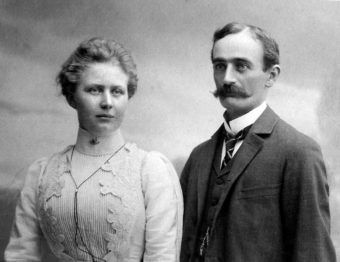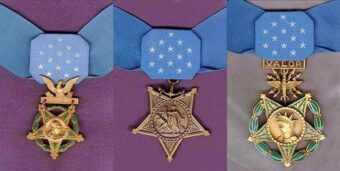
Born in 1869 in a small village located in what was then the Kingdom of Bavaria called, Kallstadt, Frederick (who went by the decidedly more German sounding “Friedrich” prior to moving to the states) had a fairly humble upbringing. One of 6 children, he was the son of not terribly well off grape growers in the region. Matters got worse for the family in 1877 when Fred’s father, Johannes, died at the age of 48, leaving a wife, 6 children, and quite a bit of debt.
To get by, five of the six children were expected to work the fields, but it was decided by his mother, Katharina, that Frederick lacked the physical constitution for manual labor, being a sickly child. Instead, the decision was made by his mother for him to do something a little less labor intensive, and thus, she sent him off to apprentice as a barber in 1883. The young Trump was just 14 at the time.
By all accounts Friedrich was an eager student of the trade, working almost literally every day for two years straight to hone his hair care craft. However, upon completing his training and returning to his small village, Friedrich found that Kallstadt simply did not have enough people living there for him to support himself as a barber. It was at this point that he decided that he, like so many immigrants before and after him, would seek work and his fortune in the land of opportunity- the United States.
The exact conditions under which Friedrich left his homeland aren’t clear, with Friedrich himself later claiming that his mother urged him to emigrate and that he did so to comply with her wishes. However, others claim that Friedrich essentially fled the country, stealing away at night, leaving behind only a note explaining his departure to his family. It is sometimes suggested that this latter claim is supported by the fact that the government received no formal notification from Friedrich in 1885 declaring his intentions before he left- something that he was required to do and will become important later. That said, it would also appear his sister, who had already made the trip across the pond, knew he was coming, so seemingly it wasn’t a surprise to everyone.
Whatever his motives, the 16 year old Friedrich, along with hundreds of other immigrants, sailed into New York aboard the S.S. Eider, hoping to find a better life for themselves. With only a single suitcase of belongings to his name, Friedrich was quizzed by immigration authorities where, amongst other things, it was recorded that he had no listed occupation.
Yes, regardless of one’s position on the political spectrum, I think we can all appreciate the irony of Donald Trump and his amazing hair being the direct descendant of an unemployed immigrant hair care specialist who came to the United States looking to find a job…
Although he had little to his name upon arriving in America, as alluded to, Frederick did have an advantage over other immigrants in the form of his sister, Katherine, who’d similarly moved to America a few years earlier and had settled and married a clerk named, oddly enough, Friedrich. Frederick’s sister put him up in her modest apartment located in modern day Chinatown, which at the time was an area filled with businesses operated and owned by German immigrants. Frederick soon took a job that could have otherwise been filled by a U.S. citizen,  by securing himself work as barber, with some reports saying he had a job within 24 hours of first setting foot on American soil.
by securing himself work as barber, with some reports saying he had a job within 24 hours of first setting foot on American soil.
Whether that’s true or not, Frederick stayed in New York for 6 years, amassing a little nest egg of several hundred dollars (equivalent to about $10,000 today). While nothing special, it was enough that, in 1891, Frederick was able to move to Seattle where he invested his money in the thing that would eventually form the basis of the later family fortune- property.
Frederick first headed for an area of Seattle known as the Lava Beds, which was smack bang in the middle of the red light district. There, he leased a restaurant called, and we’re not making this up- The Poodle Dog. The Poodle Dog, later renamed the Dairy Restaurant, offered weary travellers food, alcohol and the company of a woman- for the right price of course.
You see, like many restaurants and saloons of the era, Frederick’s establishment advertised that it had “private rooms for ladies”, which was a standard way to advertise that your business offered the services of prostitutes. This has led to a persistent idea that the Trump family’s fortune was made primarily by selling alcohol and sex to the masses. However, this isn’t really accurate as you’ll soon see. Or, at the least, if you’d still consider it accurate after we explain, it would arguably be just as accurate, and infinitely more humorous given his grandson’s world famous hair, to go with the basis of the family fortune being Frederick working as a barber.
In any event, from here, Frederick re-invested the profits from his little saloon/brothel into other ventures about Seattle, particularly in the nearby mining town of Monte Cristo. Not one for mining, Frederick similarly invested in property and slowly grew his net worth that way- a decision described by a biographers as “mining the miners”.
Most importantly, while operating in Monte Cristo, Frederick decided to fund a pair of miners working in Yukon, mere months before the Klondike gold rush of 1896. This would become one of the first of many bizarrely fortunate business decisions made by Frederick in his adult years.
During the Klondike gold rush, Frederick decided against personally heading to the region at first, instead opting to move away from Monte Cristo back to Seattle, selling most of his property there. This again proved to be miraculously fortunate for Frederick as it soon turned out that prospectors had greatly overestimated the value of the silver deposits in the area leading to a collapse of the town’s economy a short while after Fred vacated the area.
As if that wasn’t unusual enough, it’s noted that a year after Frederick sold off the last of his property in the region, it was devastated by both floods and avalanches, ruining the livelihood of many who still had investments in the town. (We’re pretty sure given this and other key events required to produce The Donald as we know him, that the Adjustment Bureau was definitely involved…)
By 1898, the miners Frederick had funded made several claims worth the modern equivalent of thousands, if not tens of thousands of dollars, convincing him to sell off the remainder of his property to reinvest it in the Yukon region. As before, Frederick didn’t invest his money into mining endeavours themselves, instead opting to make his fortune providing food, drink and female companionship to lonely miners.
Note here, Frederick’s business partner during this time was a man called Ernest Levin, whom he met while travelling to Bennett in British Columbia.
Showing a hint of the flair for opulence and grandeur his grandson would eventually make his trademark, Frederick’s first investment in the area- a hotel/restaurant called The Arctic- was billed as the grandest and most luxurious around. Starting as a simple tent that sold frozen horse meat, the Arctic soon became the premier destination for miners to spend their profits on pleasures and drown their sorrows respectively. As one contemporary report that appeared in the Yukon Sun noted of the establishment,
For single men the Arctic has excellent accommodations as well as the best restaurant in Bennett, but I would not advise respectable women to go there to sleep as they are liable to hear that which would be repugnant to their feelings – and uttered, too, by the depraved of their own sex.
When the town of Bennett no longer became the first port of call for miners looking to make their fortunes after the construction of a railway that bypassed it entirely, Frederick simply moved the hotel to the new hottest destination for miners, Whitehorse. And, note here, when we say “he moved the Arctic”, we mean that literally- as in, he paid to have the whole thing dismantled and rebuilt in the new location from the same materials as the original.
In 1901, despite the Arctic making massive profits, including at its peak apparently serving a few thousand meals a day to hungry miners, and being a hotbed of gambling and other ways for lonely men to spend their money, Frederick suddenly decided to call it quits, selling his share of the enterprise to Levin.
Frederick’s decision was partly inspired by issues with his rather frequently inebriated business partner, but also due to a desire to return to his hometown and allegedly due to rumblings he’d heard that the government was about to try and curb instances of public rowdiness by cracking down on establishments selling alcohol and the services of the ladies of the night- basically everything that made the Arctic popular.
Once again Frederick showed an almost uncanny level of business foresight and a year later the businesses profits were massively hampered by governmental interference. This drove his former business partner further to drink himself into a stupor at which point he was promptly arrested and the business was taken over by Canadian Mounties. A few years later, in 1905, the Arctic burned down.
But here’s where things got weird for the patriarch of the Trump empire. He returned to his native Kallstadt for a visit. While there, he encountered a former neighbor who had been just 5 years old when he last saw her when he was 16. However, Elizabeth Christ was all grown up now at the age of 21 and Frederick became absolutely smitten with her. Despite strong objections from Fred’s mother owing to the supposed lower social standing of the Christ family, Frederick ignored his mom’s wishes and eventually proposed to Elizabeth. She accepted and the pair got married. While apparently hesitant to immigrate to America, Elizabeth ultimately agreed and the couple moved to New York.
Back in the U.S., Trump invested his money in a hotel that he not only managed, but worked as a barber in. However, almost immediately after the birth of their first child, Elizabeth, in April of 1904, his wife became extremely homesick and the pair decided to move back to Kallstadt a few months later- at the time, apparently intent on remaining there forever.
So why did they come back to the United States?
Well, soon after returning to Germany and depositing the equivalent of half a million dollars in today’s money into an account there, his entire net worth at the time, authorities revoked Frederick’s citizenship.
You see, not only had Frederick failed to de-register himself when he left, but he also left shortly before he would have been eligible for mandatory military service. Thus, the German government deemed that he’d intentionally left the country to avoid it.
If this is true, it’s always possible given he had been a sickly child and his mother had deemed him unfit for physical activity that she really had encouraged him to move to America, perhaps to avoid military service.
Whatever the case, accounts do seem to indicate that when he left Germany, he hadn’t bothered to de-register or worry about the military service issue as he had never actually intended to move back to Germany permanently, so didn’t think it would matter.
In the end, Frederick pleaded with the government to reverse their decision on his citizenship status, including in his note to Prince Regent Luitpold calling him “the much-loved, noble, wise and righteous sovereign and sublime ruler” to butter him up. Proving once again that the Adjustment Bureau were involved, fortunately for Fred given events in Germany that were just around the corner, this bit of buttering the Princely roll didn’t work, nor did his legal argument on the matter.
You see, the law that decreed anyone who immigrated to North America to avoid mandatory military service would lose their citizenship wasn’t a thing until 1886- the year AFTER Frederick had already left the country. Thus, he didn’t think he should be subjected to that loss of citizenship for doing something that wasn’t a law at the time he did it.
In the end, his pleas fell on deaf ears, however, and he was unceremoniously asked to leave the country within 8 weeks, with his daughter, and pregnant wife, who at the time was carrying Donald Trump’s father, Fred.
And so it was that on July 1, 1905, the little family were deported from Germany and headed back to New York, with Donald Trump’s father, Fred, born just a few months later an American citizen instead of a German one.
Frederick’s later life was relatively unremarkable, simply continuing to work in the hotel, hair, and lodging industry throughout the early 20th century until his untimely death from pneumonia at the start of the 1918 Spanish Flu Pandemic- one of the early deaths attributed to that particular pandemic.
Frederick was 49 when he died and left behind an estimated net worth of around $32,000, the modern equivalent of about $550,000 today. This, again, is why it’s not quite accurate to say the Trump family fortune was made from gambling, hair cutting, and prostitution. While that’s no small amount of money, for a lifetime of reasonably successful business and hair care work, it’s not exactly a remarkable net worth for that age bracket. Certainly comfortable, but not a fortune- more like a great seed for a very comfortable retirement had he lived long enough.
The real rather large family fortune wouldn’t come until later, with Frederick’s wife, Elizabeth, taking over management of the tiny real estate company, which at the time held 14 mortgages, a few stocks, and a handful of vacant lots of land.
She did well in this and, at the same time, Donald’s father, Fred, began learning the trade of carpentry, including building his first home when he was still just a teen. The goal was to use these skills to build houses on lots of land and sell or rent them for profit. On that note, teaming up with her son, Elizabeth formed the company Elizabeth Trump & Son, which she ran until Fred turned 21. It is this company that would eventually evolve into the more famous The Trump Organization.
And so it was that, finally, with mother and son working together, the reasonably successful little small business began to grow into something much greater, with the company having built a couple dozen homes by 1926 when Fred took the lead. Within a decade, they had expanded into all manner of real estate projects, including creating one of the earliest supermarket stores- the Trump Market.
It was during this period, The Donald’s father met a Scottish Immigrant by the name of Mary Anne Macleod who had come to American when she was 18 to escape the rather extreme poverty that was ravaging her native land. With about $50 to her name and sisters already having immigrated to America, she crossed the pond in search of a better life- one she found. While initially working as a nanny and other similar domestic jobs where she could find them, one fateful day in the early 1930s she attended a dance where she caught the eye of Fred Trump. In January of 1936, the pair were married. About a decade and three other children later, in 1946, she gave birth to her fourth of ultimately five children- future president Donald Trump.
And the rest, as they say, is history.
If you liked this article, you might also enjoy our new popular podcast, The BrainFood Show (iTunes, Spotify, Google Play Music, Feed), as well as:
- Does the President Get Sick Days?
- The President Who Randomly Liked to Challenge People to Fist-Fights
- Does the U.S. President’s Dog Get Its Own Secret Service Agents?
- Why Do Presidents Get to Pardon People at the End of Their Terms?
- Why Does the United States Use the Electoral College Instead of a Simple Vote Count When Deciding the Next President?
Bonus Facts:
- As you might expect given the political climate the first half of the 20th century, Both Fred Trumps are known to have greatly downplayed their German heritage once that became a thing to hide in many regions of the world. As to the younger Fred, during WWII, he even went so far as to claim he was actually the heir of Swedish immigrants. Even after the war, he maintained this ruse because he was worried that many of his Jewish tenants wouldn’t want to continue to buy or rent property from a person of German heritage. Interestingly, Donald was reportedly annoyed by the fact that his father insisted that the family was of Swedish descent, supposedly asking his father “Do I have to do this Swedish thing?” while writing The Art of the Deal in the 1980s. Apparently he did have to do the Swedish thing because the book claimed that Trump’s grandfather “came here from Sweden as a child”.
- Donald Trump is a self-admitted germaphobe who dislikes both shaking hands and touching food. In fact, Trump often refers to the practise of shaking hands as “barbaric” in his books and notes that he usually refrains from doing it with people he doesn’t like. Curiously, when Trump floated the idea of running for president in 2011 this very fact was touted by some as a reason he could never be elected, as shaking hands is seen as such an integral aspect of establishing the character of a candidate that his inability or unwillingness to do it would be his undoing. When asked if his aversion to shaking hands in an interview would prevent him from doing it on the campaign trail, Trump begrudgingly acknowledged that he would shake hands with the public, before adding he’d personally prefer to kiss babies though.
- The Trumps: Three Generations That Built an Empire
- Donald Trump’s grandfather was banished from Germany, records reveal
- An Immigrant Named Trump
- Granddaddy Trump
- Historian finds German decree banishing Trump’s grandfather
- Donald Trump’s roots: a German immigrant saga that runs through the Northwest
- Trump’s Family Fortune Originated in a Canadian Gold-Rush Brothel
- Frederick Trump
- Fred Trump
- Mary Trump Barry
- Elizabeth Christ Trump
- Mary Trump
The post Coming to America: The Life of Frederick Trump appeared first on Today I Found Out.
from Today I Found Out
by Karl Smallwood - June 24, 2020 at 12:05AM
Article provided by the producers of one of our Favorite YouTube Channels!
-

 At the time of writing this, conman Steven Jay Russell is sitting in a 6×9 ft maximum security isolation cell where he is sentenced to spend the next century and a half- 22 to 23 hours per day, only let out for things like showers, a little exercise, and to see the occasional visitor during visiting hours. However, even then he is only allowed to see people through a rather thick pane of glass, and not allowed to touch or be touched by anyone other than the guards who strip him any time he leaves or enter his cell.
At the time of writing this, conman Steven Jay Russell is sitting in a 6×9 ft maximum security isolation cell where he is sentenced to spend the next century and a half- 22 to 23 hours per day, only let out for things like showers, a little exercise, and to see the occasional visitor during visiting hours. However, even then he is only allowed to see people through a rather thick pane of glass, and not allowed to touch or be touched by anyone other than the guards who strip him any time he leaves or enter his cell. Anyone who’s ever watched pretty much any movie in the history of ever or otherwise watched professional pugilists spar words with one another in a media session knows that those trained in the art of kicking ass are required to register their hands as deadly weapons in the United States. Further, if they use their fists of fury against the general public, not only will they get thrown in the slammer for a rather long time for assault with a deadly weapon, but afterwards they’ll go on a high flying adventure with the likes of Cyrus The Virus Grissom and his band of lovable ragamuffins. But is any of this actually true in reality? Well, as the universe hates simplicity and basically nothing is black and white- no, and also yes, and then nuance.
Anyone who’s ever watched pretty much any movie in the history of ever or otherwise watched professional pugilists spar words with one another in a media session knows that those trained in the art of kicking ass are required to register their hands as deadly weapons in the United States. Further, if they use their fists of fury against the general public, not only will they get thrown in the slammer for a rather long time for assault with a deadly weapon, but afterwards they’ll go on a high flying adventure with the likes of Cyrus The Virus Grissom and his band of lovable ragamuffins. But is any of this actually true in reality? Well, as the universe hates simplicity and basically nothing is black and white- no, and also yes, and then nuance.







 In the early going, knighthood was an honor earned by those who had distinguished themselves in battle in some significant way or otherwise had made themselves into an absolutely exceptional soldier through many years of training. Later, the honor became somewhat more exclusive, generally limited to nobility or those who were the children of knights, but still typically requiring extensive military training. In modern times of course, in places like the UK, knighthoods are typically granted for all manner of services to a nation, regardless of whether the person has any military training whatsoever. As for the U.S. Medal of Honor, first introduced in 1861, much like in the earliest days of knighthood, this is earned via some extremely heroic act done in aid of the U.S. military. But what do you actually get out of either of these things (or both, as it’s possible to both be knighted and receive a Medal of Honor)? And, if you only received one, which would be more beneficial to you post honor?
In the early going, knighthood was an honor earned by those who had distinguished themselves in battle in some significant way or otherwise had made themselves into an absolutely exceptional soldier through many years of training. Later, the honor became somewhat more exclusive, generally limited to nobility or those who were the children of knights, but still typically requiring extensive military training. In modern times of course, in places like the UK, knighthoods are typically granted for all manner of services to a nation, regardless of whether the person has any military training whatsoever. As for the U.S. Medal of Honor, first introduced in 1861, much like in the earliest days of knighthood, this is earned via some extremely heroic act done in aid of the U.S. military. But what do you actually get out of either of these things (or both, as it’s possible to both be knighted and receive a Medal of Honor)? And, if you only received one, which would be more beneficial to you post honor?